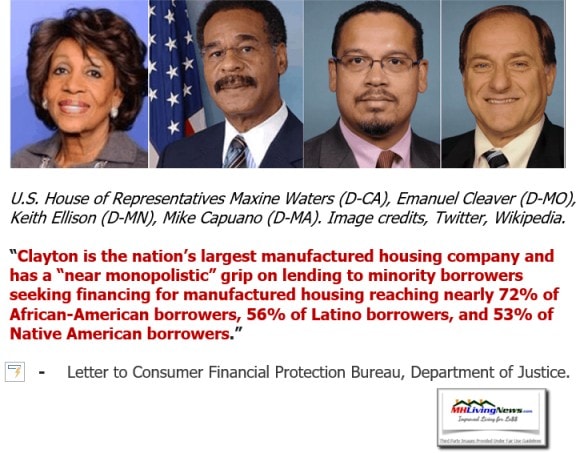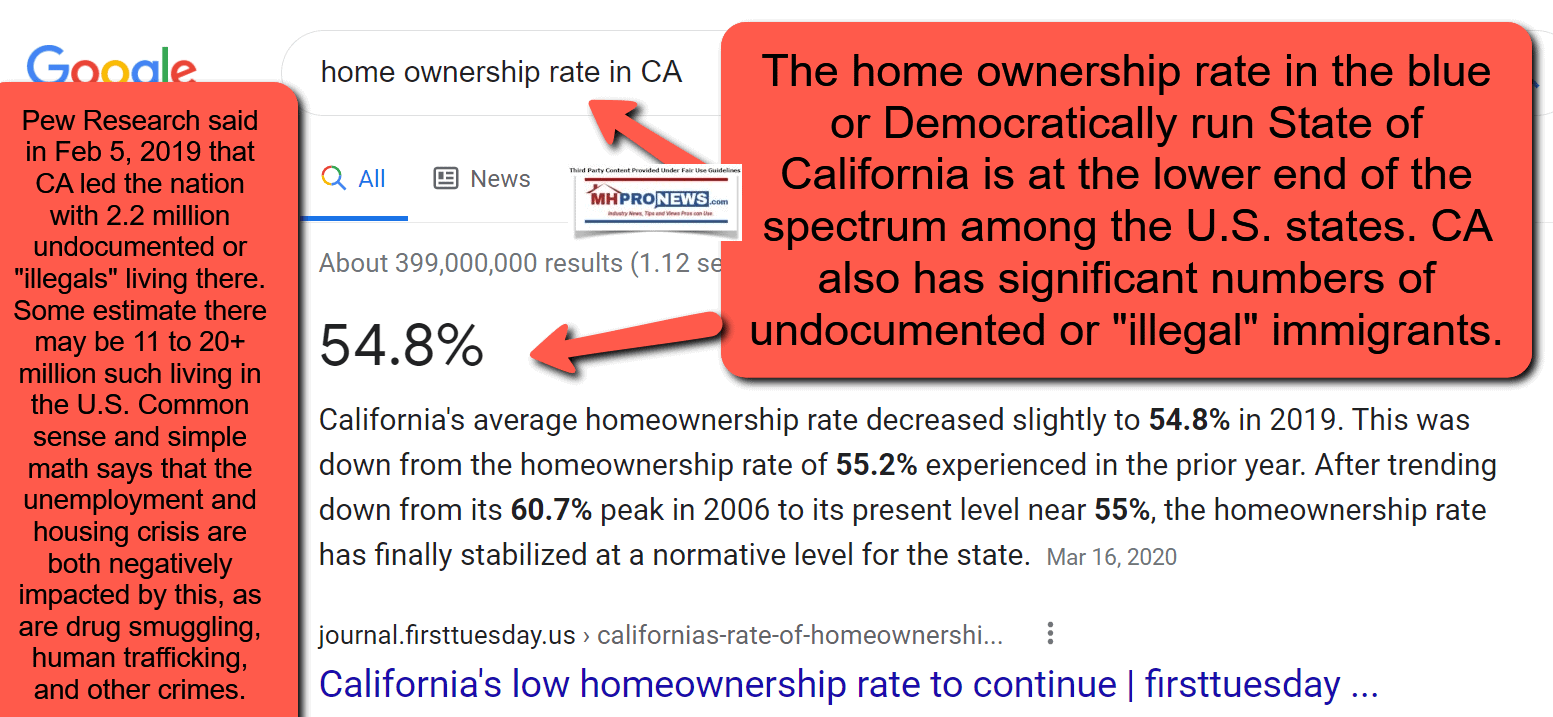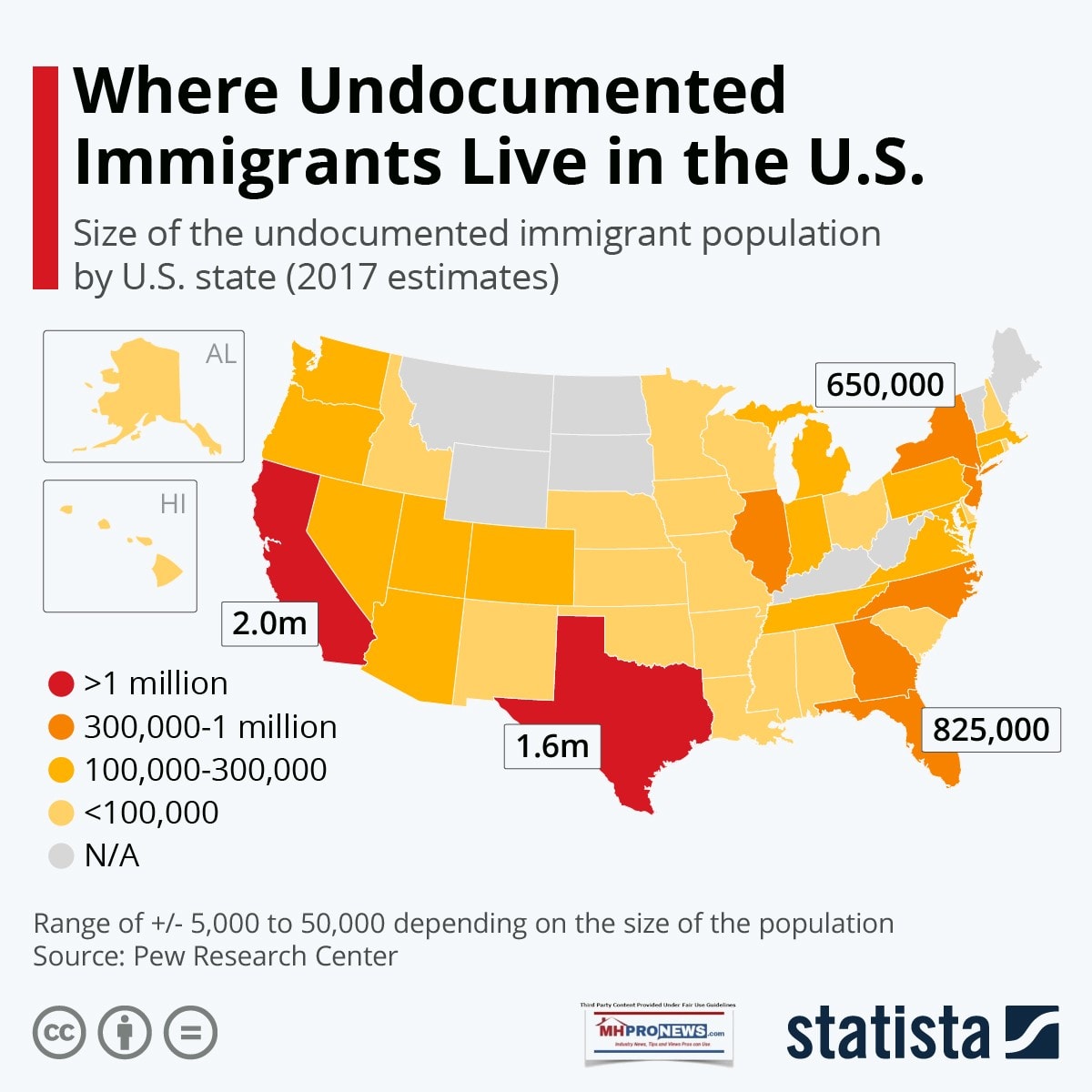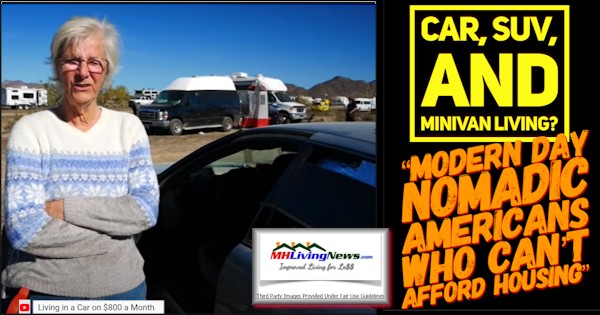The following media release from HUD will be followed by an MHProNews Analysis and Commentary on how this aligns with third-party data plus recent statements as promoted by the Manufactured Housing Institute (MHI).
U.S. Department of Housing and Urban Development – Marcia L. Fudge, Secretary
Office of Public Affairs, Washington, DC 20410
HUD No. 21-041 FOR RELEASE
HUD Public Affairs Thursday
202-708-0685 March 18, 2021
HUD Releases 2020 Annual Homeless Assessment Report Part 1
Homelessness Increasing Even Prior to COVID-19 Pandemic

WASHINGTON—The U.S. Department of Housing and Urban Development (HUD) today released its 2020 Annual Homeless Assessment Report Part 1 to Congress. The report found that 580,466 people experienced homelessness in the United States on a single night in 2020, an increase of 12,751 people, or 2.2 percent, from 2019.
The report found that between 2019 and 2020, homelessness increased significantly among unsheltered populations and people experiencing chronic homelessness. Veteran homelessness did not decrease compared with 2019, and homelessness among family households did not decrease for the first time since 2010. The report also found that people of color are significantly over-represented among people experiencing homelessness.
“The findings of the 2020 AHAR Part 1 Report are very troubling, even before you consider what COVID-19 has done to make the homelessness crisis worse,” said Secretary of Housing and Urban Development Marcia L. Fudge. “Thanks to President Biden’s leadership, we are once again putting Housing First to end this crisis and build strong, healthy communities, as reflected in the American Rescue Plan. I look forward to working with President Biden to implement this historic package to deliver robust, equitable relief to those experiencing homelessness. Housing should be a right, not a privilege, and ensuring that every American has a safe, stable home is a national imperative.”
“Even a slight pre-pandemic uptick in Veteran homelessness after significant declines since 2010 is extremely concerning,” said Secretary of Veterans Affairs Denis McDonough. “The Biden Administration’s recommitment to Housing First – a proven strategy and dignified way to help Veterans and others achieve stable, permanent housing — will help accelerate progress in preventing and eliminating Veteran homelessness. The American Rescue Plan will also make a major impact in improving outcomes for Veterans by expanding access to community-based homeless prevention and rapid rehousing services for those who may not qualify for VA care.”
HUD releases the Annual Homeless Assessment Report to Congress (AHAR) in two parts. Part 1 provides Point-in-Time (PIT) estimates, offering a snapshot of homelessness—both sheltered and unsheltered—on a single night. The one-night counts are conducted during the last 10 days of January each year. The PIT counts also provide an estimate of the number of people experiencing homelessness within particular homeless populations such as individuals with chronic patterns of homelessness and veterans experiencing homelessness.
In 2020, the PIT estimates of people experiencing homelessness in sheltered and unsheltered locations, as well as the number of beds available to serve them, were reported by 396 Continuums of Care (CoC) nationwide. These 396 CoCs covered virtually the entire United States.
The Point-in-Time counts of homelessness and the housing inventory information are based on data from January 2020 and thus do not reflect the health or economic consequences of the COVID-19 pandemic for levels of homelessness or characteristic of people experiencing homelessness.
Key Findings of HUD’s 2020 Annual Homeless Assessment Report Part 1:
- On a single night in January 2020, 580,466 people – about 18 of every 10,000 people in the United States – experienced homelessness across the United States. This represents a 2.2 percent increase from 2019.
- After steady reductions from 2010 to 2016, homelessness has increased in the last four consecutive years.
- The increase in homelessness was due to the rise in unsheltered individuals (a 7 percent increase from 2019) and this increase impacted the large increase in individuals experiencing chronic homelessness (a 15 percent increase since 2019). The increase in unsheltered homelessness is driven largely by increases in California and coincide with increases in overall homelessness.
- Veteran homelessness did not decline in 2020. 2020 was the first year that homelessness among family households did not fall since 2010.
- Youth homelessness is slightly down (a 2.2 percent decrease from 2019).
- People of color are significantly over-represented among people experiencing homelessness.
Homelessness Among All People
The total number of people experiencing homelessness on a single night in January 2020 is 580,466, an increase of 2.2 percent from January 2019 driven by increases in the unsheltered homeless population. The number of people experiencing homelessness nationwide increased by two percent between 2019 and 2020, or 12,751 more people. This marks the fourth consecutive year that total homelessness has increased in the United States.
Chronic Homelessness
On a single night in January 2020, there were 110,528 individuals experiencing chronic homelessness, just over one-quarter of all homeless individuals. This is the first time since 2011 that the number of people with chronic patterns of homelessness exceeded 100,000. The number of people experiencing chronic homelessness increased 15 percent from 2019.
Unsheltered Homelessness
On a single night in 2020, nearly four in ten (39 percent or 226,080 people) were in unsheltered locations such as on the street, in abandoned buildings, or in other places not suitable for human habitation. Between 2019 and 2020, the number of people counted in unsheltered locations rose by 7 percent or 14,787 people. 2020 marks the first time since data collection began that more individuals experiencing homelessness were unsheltered than were sheltered. Between 2019 and 2020, the number of unsheltered individuals increased by seven percent while the number of sheltered individuals remained largely unchanged. Increases in the unsheltered population occurred across all geographic categories.
Family Homelessness
There were 171,575 people in families with children who experienced homelessness on a single night in 2020, essentially the same as in 2019. Nine in ten people experiencing homelessness in families with children were sheltered, 154,908 people. Ten percent of people in families with children, 16,667 people, were found in unsheltered locations.
Veteran Homelessness
On a single night in January 2020, 37,252 veterans were experiencing homelessness in the U.S., eight percent of all homeless adults. Between 2019 and 2020, the number of veterans experiencing homelessness increased by less than one percent (167 more people). The increase was entirely among veterans staying in unsheltered places (859 more veterans). However, in 2020 36,115 fewer veterans were experiencing homelessness than in 2009, when these data were first reported, a drop of nearly 50 percent.
Homelessness Among People of Color
African Americans and indigenous people (including Native Americans and Pacific Islanders) remained considerably overrepresented among the homeless population compared to the U.S. population. Almost 4 of every 10 people experiencing homelessness in January 2020 were Black or African American (39% or 228,796 people). A higher percentage of people in shelters were Black or African American (47% or 167,205 people) than were people experiencing homelessness in unsheltered locations (27% or 61,591). Almost a quarter of all people experiencing homelessness, 23 percent, were Hispanic or Latino (counting people of all races who identify as Hispanic or Latino). Together, American Indian, Alaska Native, Pacific Islander and Native Hawaiian populations account for one percent of the U.S. population, but five percent of the homeless population and seven percent of the unsheltered population.
##
HUD’s mission is to create strong, sustainable, inclusive communities and quality affordable homes for all.
More information about HUD and its programs is available on the Internet
###


Additional Information, MHProNews Analysis and Commentary
The data taken at face value is sobering. But it should also be considered in the broader context reflected in the housing trend-line graphic above. During both Democratic and Republican administrations, the overall rate of home ownership has declined since 2000. During the Trump Administration that trend was reversing. As employment opportunities for people of all backgrounds rose to multi-decade record levels, the rate of home ownership grew during the Trump years. Nevertheless, it was still below the level of 2000. That was the year that Congress passed the Manufactured Housing Improvement Act (MHIA or 2000 Reform Law). It was supposed to spur more affordable home ownership, which must be considered near the heart of the affordable housing crisis.
Despite the praise for what the release called “…Biden’s leadership, we are once again putting Housing First to end this crisis and build strong, healthy communities, as reflected in the American Rescue Plan.”
The Manufactured Housing Institute (MHI) purportedly staged some comments with then Representative Fudge while she was still being vetted by the U.S. Senate.
MHI said that during her confirmation hearings – quoting their March 10, 2021 ‘news’ item – that : “Fudge called manufactured housing an “outstanding option,” and she touted its affordability and efficiency. She told the Senate Committee that she is “100% supportive” of looking at incorporating manufactured housing into the Department’s affordable housing strategies.” However, in this significant homelessness report that is clearly connected to housing affordability, there was no mention of manufactured housing as being part of the solution in the above. More details are in the report linked below.

On a practical level, how can affordable housing or homelessness be fixed when the southern border crisis – arguably sparked by suspension of the border wall and Trump-era border control policies – are surging the numbers of undocumented people crossing the southern border at what is being described at a 20-year record high?

Why is there fencing and National Guard troops around the U.S. Capital, but not more of that being deployed on the southern border? These are the reasons that analysis of dubious or debunked media claims matter, see the latest Glenn Greenwald analysis of purported media malpractice and propaganda linked here.


It is not pretty words, nor Bush-Cheney-Obama-Biden redux policies that will fix either the American economy, nor affordable housing, nor the border crisis.


The latter also undermines lower income citizens who will be forced to compete with illegal entrants into the U.S. for work. It should be recalled that Hispanics in Texas border counties voted for Trump in 2020. They understand that a secure border benefits them. So this is not a color or racial issue, as some on the left like to cast it. Rather, it is a common sense solution to problems that are being politicized for the benefit of the backers of Democratic leaders and certain “RINO” Republicans too.
As demonstration of the notion that this is not a ‘racist’ issue, NPR said on November 5, 2020 “Zapata County is a hardscrabble land of ranchers, oil field workers and bass fishermen. It’s 93% Hispanic and hasn’t voted Republican in a presidential race since it went for Warren G. Harding a century ago – until 2020. Trump won Zapata and did better than expected up and down the winding Rio Grande, while Biden underperformed. He carried the South Texas border counties by only 11 points, compared to Hillary Clinton’s 44-point spread in 2016.”
Barbara Ocañas told the Guardian that “liberal Democrats just fundamentally misunderstand Latino voters – and talk down to them,” “almost like we’re stupid, almost like we’re children,” she said. People of all backgrounds want opportunities, not platitudes.
On a range of issues, what conservative “Washington’s Mall” talker Chris Plante is calling the “Biden-Harris Junta” are implementing policies that are going to make people long for the more common sense, America First and Americans First policies of the Trump-Pence years. While millions did not care for the Trump-persona, counterpunching style, or numbers of his tweets, even a Democratic backer in manufactured housing told MHProNews recently that Trump’s policies were more common sense.
As President Trump said at the recent CPAC 2021 conference, “Do you miss me yet?”




Stay tuned for more of what is ‘behind the curtains’ as well as what is obvious and in your face reports. It is all here, at the runaway largest and most-read source for authentic manufactured home “News through the lens of manufactured homes and factory-built housing” © where “We Provide, You Decide.” © ## (Affordable housing, manufactured homes, reports, fact-checks, analysis, and commentary. Third-party images or content are provided under fair use guidelines for media.) (See Related Reports, further below. Text/image boxes often are hot-linked to other reports that can be access by clicking on them.)

By L.A. “Tony” Kovach – for MHProNews.com.
Tony earned a journalism scholarship and earned numerous awards in history and in manufactured housing.
For example, he earned the prestigious Lottinville Award in history from the University of Oklahoma, where he studied history and business management. He’s a managing member and co-founder of LifeStyle Factory Homes, LLC, the parent company to MHProNews, and MHLivingNews.com.
This article reflects the LLC’s and/or the writer’s position, and may or may not reflect the views of sponsors or supporters.
Connect on LinkedIn: http://www.linkedin.com/in/latonykovach
Related References:
The text/image boxes below are linked to other reports, which can be accessed by clicking on them.
































